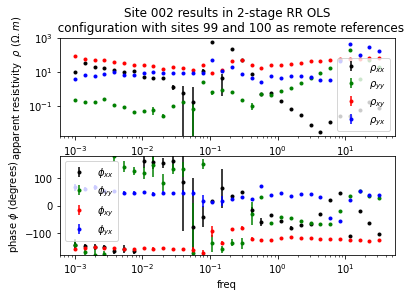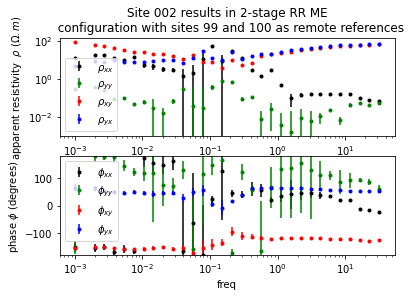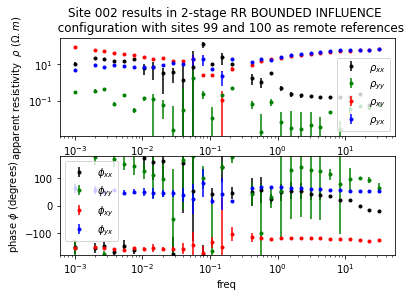Survey Study: a tutorial¶
This Jupyter notebook aims to help razorback users to compute impedance estimates from the data set shown in the paper in different ways for a two stage remote reference configuration:
1- Ordinary Least Squares
2- M-Estimator
3- Bounded Influence
This tutorial is designed for Metronix data format (.ats files).
[1]:
import razorback as rb # importing the razorback library
import numpy as np # importing the numpy library as np
import matplotlib.pyplot as plt # importing the matplotlib.pyplot library as plt
%matplotlib inline
[2]:
# function for getting sensor information from .ats file header
def sensor(ats_file):
header = rb.io.ats.read_ats_header(ats_file) #razorback function for ats file data importation
chan = header['channel_type'].decode()
stype = ''.join(c for c in header['sensor_type'].decode() if c.isprintable())
snum = header['sensor_serial_number']
sampling_rate = header['sampling_rate']
x1, y1, z1 = header['x1'], header['y1'], header['z1']
x2, y2, z2 = header['x2'], header['y2'], header['z2']
L = ((x1-x2)**2 + (y1-y2)**2 + (z1-z2)**2)**.5
return chan, L, stype, snum, sampling_rate
[3]:
# function for getting calibration function from sensor information
def calibration(ats_file, name_converter=None):
chan, L, stype, snum, sampling_rate = sensor(ats_file)
if chan in ('Ex', 'Ey'):
return L
elif chan in ('Hx', 'Hy', 'Hz'):
calib_name = f"{stype}{snum:03d}.txt"
if name_converter:
calib_name = name_converter.get(calib_name, calib_name)
return rb.calibrations.metronix(calib_name, sampling_rate)
raise Exception(f"Unknown channel name: {chan}")
The functions sensor() and calibration() will help to load the metadata of the data set (electric dipoles length, orientation, calibration files…).
Other strategies for handling these metadata could be used, it’s up to you to design your own.
[4]:
import glob
## Create the inventory containing all the time series
# - files is the list of data files to load
# - pattern is applied to each data file to extract the strings {site} and {channel}
# - tag_template create the tag for the data file using {site} and {channel}
files = glob.glob("data/site*/*/*.ats")
pattern = "*/site{site}/*/*_T{channel}_*.ats"
tag_template = "site{site}_{channel}"
# correcting incorrect information about calibration files in file headers
name_converter = {
'UNKN_H104.txt': 'MFS07104.txt',
'UNKN_H105.txt': 'MFS07105.txt',
}
# creating and filling the inventory
inv = rb.Inventory()
for fname, [tag] in rb.utils.tags_from_path(files, pattern, tag_template):
calib = calibration(fname, name_converter) # getting calibration for data file
signal = rb.io.ats.load_ats([fname], [calib]) # loading data file
inv.append(rb.SignalSet({tag:0}, signal)) # tagging and storing the signal
All the data are now loaded in inventory. We can use inventory to explore and handle the data set.
You can check the number of files in your inventory inv:
[5]:
len(inv)
[5]:
24
You can display the tags/labels included in the inventory inv
[6]:
inv.tags
[6]:
{'site002_Ex',
'site002_Ey',
'site002_Hx',
'site002_Hy',
'site002_Hz',
'site004_Ex',
'site004_Ey',
'site004_Hx',
'site004_Hy',
'site004_Hz',
'site006_Ex',
'site006_Ey',
'site006_Hx',
'site006_Hy',
'site006_Hz',
'site009_Ex',
'site009_Ey',
'site009_Hx',
'site009_Hy',
'site009_Hz',
'site099_Hx',
'site099_Hy',
'site100_Hx',
'site100_Hy'}
Creating (using pack()) and showing (using print()) the SignalSet object for site004 only:
[7]:
print(inv.filter('site004*').pack())
SignalSet: 5 channels, 1 run
tags: {'site004_Ex': (0,), 'site004_Ey': (1,),
'site004_Hx': (2,), 'site004_Hy': (3,),
'site004_Hz': (4,)}
---------- ------------------- -------------------
sampling start stop
128 2016-04-28 19:00:00 2016-04-29 07:00:00
---------- ------------------- -------------------
Same operation for site099 (magnetic remote reference only):
[8]:
print(inv.filter('site099*').pack())
SignalSet: 2 channels, 1 run
tags: {'site099_Hx': (0,), 'site099_Hy': (1,)}
---------- ------------------- -------------------
sampling start stop
128 2016-04-28 19:00:00 2016-04-29 17:59:00
---------- ------------------- -------------------
Creating and showing the SignalSet object content for the full inventory (including sites 002, 004, 006, 009, 100, 099). The full data set is reduced to maximal synchronous time section. The pack() function is narrowing the time range to the window of common synchronousness of the whole inventory.
[9]:
print(inv.pack())
SignalSet: 24 channels, 1 run
tags: {'site002_Ex': (0,), 'site002_Ey': (1,),
'site002_Hx': (2,), 'site002_Hy': (3,),
'site002_Hz': (4,), 'site004_Ex': (5,),
'site004_Ey': (6,), 'site004_Hx': (7,),
'site004_Hy': (8,), 'site004_Hz': (9,),
'site006_Ex': (10,), 'site006_Ey': (11,),
'site006_Hx': (12,), 'site006_Hy': (13,),
'site006_Hz': (14,), 'site009_Ex': (15,),
'site009_Ey': (16,), 'site009_Hx': (17,),
'site009_Hy': (18,), 'site009_Hz': (19,),
'site099_Hx': (20,), 'site099_Hy': (21,),
'site100_Hx': (22,), 'site100_Hy': (23,)}
---------- ------------------- -------------------
sampling start stop
128 2016-04-28 19:00:00 2016-04-29 04:00:05
---------- ------------------- -------------------
[10]:
# Function to prepare signal set from inventory to get it ready for TF estimation procedure
from itertools import chain
def prepare_signalset(inventory, local_site, remote_sites):
patterns = (f"{e}*" for e in [local_site, *remote_sites])
signalset = inventory.filter(*patterns).pack()
tags = signalset.tags
tags["E"] = tags[f"{local_site}_Ex"] + tags[f"{local_site}_Ey"]
tags["B"] = tags[f"{local_site}_Hx"] + tags[f"{local_site}_Hy"]
if remote_sites:
remote_names = tags.filter(*chain(*(
(f"{e}_Hx", f"{e}_Hy") for e in remote_sites
)))
tags["Bremote"] = sum((tags[n] for n in remote_names), ())
return signalset
The function prepare_signalset() build the SignalSet needed for processing a given local_site along with some remote_sites.
The function starts by extracting the channels of interest and pack them in a SignalSet. Then that signaset is enriched with specific tags ('E', 'B' and 'Bremote') that will be used later in the TF estimate function.
Showing the SignalSet object with 'E', 'B' and 'Bremote' tags for processing site004 using sites 100 and 099 as remote references
[11]:
print(prepare_signalset(inv, 'site004', ['site100', 'site099']))
SignalSet: 9 channels, 1 run
tags: {'site004_Ex': (0,), 'site004_Ey': (1,),
'site004_Hx': (2,), 'site004_Hy': (3,),
'site004_Hz': (4,), 'site099_Hx': (5,),
'site099_Hy': (6,), 'site100_Hx': (7,),
'site100_Hy': (8,), 'B': (2, 3),
'E': (0, 1), 'Bremote': (8, 6, 5, 7)}
---------- ------------------- -------------------
sampling start stop
128 2016-04-28 19:00:00 2016-04-29 07:00:00
---------- ------------------- -------------------
Defining a frequency array in logscale for TF computation
[12]:
# Definining your output frequency in logscale / you can reduce nb_freq if you want to make a quick test
# as sampling frequency is 128, we go up to half a nyquist frequency which is 32 Hz
# recordings are long enough to try to reach 1 mHz
nb_freq=32
freq = np.logspace(-3, np.log10(32), nb_freq)
print(freq)
[1.00000000e-03 1.39742149e-03 1.95278683e-03 2.72886629e-03
3.81337640e-03 5.32889414e-03 7.44671121e-03 1.04061943e-02
1.45418396e-02 2.03210792e-02 2.83971128e-02 3.96827358e-02
5.54535079e-02 7.74919238e-02 1.08288880e-01 1.51325208e-01
2.11465098e-01 2.95505873e-01 4.12946259e-01 5.77059977e-01
8.06396015e-01 1.12687512e+00 1.57471952e+00 2.20054690e+00
3.07509153e+00 4.29719900e+00 6.00499825e+00 8.39151362e+00
1.17264815e+01 1.63868373e+01 2.28993186e+01 3.20000000e+01]
Computing two-stage OLS Impedance estimate for site004 with sites 100 and 99 as remote references¶
First stage: a regression is performed to estimate the TF between magnetic field at site 4 and magnetic field at (sites 99 + 100) . Second Stage: the first stage TF is used to produce a synthetic magnetic field and a second regression is operated between the latter and site 4 electric field.
[13]:
sig = prepare_signalset(inv, 'site004', ['site100', 'site099'])
print(sig)
ImpOLS = rb.utils.impedance(sig, freq ,remote='Bremote' )
print(ImpOLS.impedance.shape)
SignalSet: 9 channels, 1 run
tags: {'site004_Ex': (0,), 'site004_Ey': (1,),
'site004_Hx': (2,), 'site004_Hy': (3,),
'site004_Hz': (4,), 'site099_Hx': (5,),
'site099_Hy': (6,), 'site100_Hx': (7,),
'site100_Hy': (8,), 'B': (2, 3),
'E': (0, 1), 'Bremote': (8, 6, 5, 7)}
---------- ------------------- -------------------
sampling start stop
128 2016-04-28 19:00:00 2016-04-29 07:00:00
---------- ------------------- -------------------
starting frequency 0.001
starting frequency 0.00139742
starting frequency 0.00195279
starting frequency 0.00272887
starting frequency 0.00381338
starting frequency 0.00532889
starting frequency 0.00744671
starting frequency 0.0104062
starting frequency 0.0145418
starting frequency 0.0203211
starting frequency 0.0283971
starting frequency 0.0396827
starting frequency 0.0554535
starting frequency 0.0774919
starting frequency 0.108289
starting frequency 0.151325
starting frequency 0.211465
starting frequency 0.295506
starting frequency 0.412946
starting frequency 0.57706
starting frequency 0.806396
starting frequency 1.12688
starting frequency 1.57472
starting frequency 2.20055
starting frequency 3.07509
starting frequency 4.2972
starting frequency 6.005
starting frequency 8.39151
starting frequency 11.7265
starting frequency 16.3868
starting frequency 22.8993
starting frequency 32
(32, 2, 2)
Showing typical apparent resistivity and phase results using matplotlib
[14]:
res = ImpOLS
rho = 1e12 * np.abs(res.impedance)**2 / freq[:, None, None]
rho_err = 1e12 * np.abs(res.error)**2 / freq[:, None, None]
phi = np.angle(res.impedance, deg=True)
rad_err = np.arcsin(res.error/abs(res.impedance))
rad_err[np.isnan(rad_err)] = np.pi
phi_err = np.rad2deg(rad_err)
fig = plt.figure()
ax = plt.subplot(2, 1, 1)
ax.set_xscale("log", nonpositive='clip')
ax.set_yscale("log", nonpositive='clip')
ax.errorbar(freq, rho[:,0,0], yerr=rho_err[:,0,0], fmt='k.', label=r'$\rho_{xx}$')
ax.errorbar(freq, rho[:,1,1], yerr=rho_err[:,1,1], fmt='g.', label=r'$\rho_{yy}$')
ax.errorbar(freq, rho[:,0,1], yerr=rho_err[:,0,1], fmt='r.', label=r'$\rho_{xy}$')
ax.errorbar(freq, rho[:,1,0], yerr=rho_err[:,1,0], fmt='b.', label=r'$\rho_{yx}$')
plt.xlabel('freq')
plt.ylabel(r'apparent resistivity $\rho$ ($\Omega.m$)');
plt.legend()
plt.title('Site 002 results in 2-stage RR OLS\n configuration with sites 99 and 100 as remote references')
ax = plt.subplot(2, 1, 2)
ax.set_xscale("log", nonpositive='clip')
ax.errorbar(freq, phi[:,0,0], yerr=phi_err[:,0,0], fmt='k.', label=r'$\phi_{xx}$')
ax.errorbar(freq, phi[:,1,1], yerr=phi_err[:,1,1], fmt='g.', label=r'$\phi_{yy}$')
ax.errorbar(freq, phi[:,0,1], yerr=phi_err[:,0,1], fmt='r.', label=r'$\phi_{xy}$')
ax.errorbar(freq, phi[:,1,0], yerr=phi_err[:,1,0], fmt='b.', label=r'$\phi_{yx}$')
plt.xlabel('freq')
plt.ylabel(r'phase $\phi$ (degrees)');
plt.legend()
plt.ylim(-180, 180)
<ipython-input-14-d5d0ebee0674>:5: RuntimeWarning: invalid value encountered in arcsin
rad_err = np.arcsin(res.error/abs(res.impedance))
[14]:
(-180.0, 180.0)

Now computing 2-stage M-Estimator Transfer Function for site004 with sites 100 and 99 as remote references¶
[15]:
from razorback.weights import mest_weights
from razorback.prefilters import cod_filter
sig = prepare_signalset(inv, 'site004', ['site100', 'site099'])
print(sig)
ImpME = rb.utils.impedance(
sig, freq,
weights= mest_weights,
remote='Bremote', # including the remotes references in the computation,
prefilter=cod_filter(0.0), # no coherency prefilter...
fourier_opts=dict( Nper= 8, overlap= 0.71) # fourier options with 8 periods by window, and 71% of overlap
)
print(ImpME.impedance.shape)
SignalSet: 9 channels, 1 run
tags: {'site004_Ex': (0,), 'site004_Ey': (1,),
'site004_Hx': (2,), 'site004_Hy': (3,),
'site004_Hz': (4,), 'site099_Hx': (5,),
'site099_Hy': (6,), 'site100_Hx': (7,),
'site100_Hy': (8,), 'B': (2, 3),
'E': (0, 1), 'Bremote': (8, 6, 5, 7)}
---------- ------------------- -------------------
sampling start stop
128 2016-04-28 19:00:00 2016-04-29 07:00:00
---------- ------------------- -------------------
starting frequency 0.001
starting frequency 0.00139742
failed to converge (maxit=100). while processing step 2 (weighting=1).
starting frequency 0.00195279
starting frequency 0.00272887
starting frequency 0.00381338
starting frequency 0.00532889
starting frequency 0.00744671
starting frequency 0.0104062
starting frequency 0.0145418
starting frequency 0.0203211
starting frequency 0.0283971
starting frequency 0.0396827
starting frequency 0.0554535
starting frequency 0.0774919
starting frequency 0.108289
starting frequency 0.151325
starting frequency 0.211465
starting frequency 0.295506
starting frequency 0.412946
starting frequency 0.57706
starting frequency 0.806396
starting frequency 1.12688
starting frequency 1.57472
starting frequency 2.20055
starting frequency 3.07509
starting frequency 4.2972
starting frequency 6.005
starting frequency 8.39151
starting frequency 11.7265
starting frequency 16.3868
starting frequency 22.8993
starting frequency 32
(32, 2, 2)
[17]:
res = ImpME
rho = 1e12 * np.abs(res.impedance)**2 / freq[:, None, None]
rho_err = 1e12 * np.abs(res.error)**2 / freq[:, None, None]
phi = np.angle(res.impedance, deg=True)
rad_err = np.arcsin(res.error/abs(res.impedance))
rad_err[np.isnan(rad_err)] = np.pi
phi_err = np.rad2deg(rad_err)
fig = plt.figure()
ax = plt.subplot(2, 1, 1)
ax.set_xscale("log", nonpositive='clip')
ax.set_yscale("log", nonpositive='clip')
ax.errorbar(freq, rho[:,0,0], yerr=rho_err[:,0,0], fmt='k.', label=r'$\rho_{xx}$')
ax.errorbar(freq, rho[:,1,1], yerr=rho_err[:,1,1], fmt='g.', label=r'$\rho_{yy}$')
ax.errorbar(freq, rho[:,0,1], yerr=rho_err[:,0,1], fmt='r.', label=r'$\rho_{xy}$')
ax.errorbar(freq, rho[:,1,0], yerr=rho_err[:,1,0], fmt='b.', label=r'$\rho_{yx}$')
plt.xlabel('freq')
plt.ylabel(r'apparent resistivity $\rho$ ($\Omega.m$)');
plt.legend()
plt.title('Site 002 results in 2-stage RR ME\n configuration with sites 99 and 100 as remote references')
ax = plt.subplot(2, 1, 2)
ax.set_xscale("log", nonpositive='clip')
ax.errorbar(freq, phi[:,0,0], yerr=phi_err[:,0,0], fmt='k.', label=r'$\phi_{xx}$')
ax.errorbar(freq, phi[:,1,1], yerr=phi_err[:,1,1], fmt='g.', label=r'$\phi_{yy}$')
ax.errorbar(freq, phi[:,0,1], yerr=phi_err[:,0,1], fmt='r.', label=r'$\phi_{xy}$')
ax.errorbar(freq, phi[:,1,0], yerr=phi_err[:,1,0], fmt='b.', label=r'$\phi_{yx}$')
plt.xlabel('freq')
plt.ylabel(r'phase $\phi$ (degrees)');
plt.legend()
plt.ylim(-180, 180)
<ipython-input-17-a0bace2a0562>:5: RuntimeWarning: invalid value encountered in arcsin
rad_err = np.arcsin(res.error/abs(res.impedance))
[17]:
(-180.0, 180.0)

Now computing 2-stage Bounded Influence Transfer Function for site004 with sites 100 and 99 as remote references for a rejection percentage of 1% and 3 bounded influence steps¶
[18]:
from razorback.weights import bi_weights
from razorback.prefilters import cod_filter
sig = prepare_signalset(inv, 'site004', ['site100', 'site099'])
print(sig)
ImpBI = rb.utils.impedance(
sig, freq,
weights= bi_weights(0.01, 3), # bounded influence with reject probability of 1% and 3 steps
remote='Bremote', # including the remotes references in the computation,
prefilter=cod_filter(0.0), # prefilter: cod_filter(0.0)
fourier_opts=dict( Nper= 8, overlap= 0.71) # fourier options with 8 periods by window, and 71% of overlap
)
print(ImpBI.impedance.shape)
SignalSet: 9 channels, 1 run
tags: {'site004_Ex': (0,), 'site004_Ey': (1,),
'site004_Hx': (2,), 'site004_Hy': (3,),
'site004_Hz': (4,), 'site099_Hx': (5,),
'site099_Hy': (6,), 'site100_Hx': (7,),
'site100_Hy': (8,), 'B': (2, 3),
'E': (0, 1), 'Bremote': (8, 6, 5, 7)}
---------- ------------------- -------------------
sampling start stop
128 2016-04-28 19:00:00 2016-04-29 07:00:00
---------- ------------------- -------------------
starting frequency 0.001
starting frequency 0.00139742
failed to converge (maxit=100). while processing step 2 (weighting=1).
starting frequency 0.00195279
starting frequency 0.00272887
starting frequency 0.00381338
starting frequency 0.00532889
starting frequency 0.00744671
starting frequency 0.0104062
starting frequency 0.0145418
starting frequency 0.0203211
starting frequency 0.0283971
starting frequency 0.0396827
starting frequency 0.0554535
starting frequency 0.0774919
starting frequency 0.108289
starting frequency 0.151325
starting frequency 0.211465
starting frequency 0.295506
failed to converge (maxit=100). while processing step 4 (weighting=1).
starting frequency 0.412946
starting frequency 0.57706
starting frequency 0.806396
starting frequency 1.12688
starting frequency 1.57472
starting frequency 2.20055
starting frequency 3.07509
starting frequency 4.2972
starting frequency 6.005
starting frequency 8.39151
starting frequency 11.7265
starting frequency 16.3868
starting frequency 22.8993
starting frequency 32
(32, 2, 2)
[19]:
res = ImpBI
rho = 1e12 * np.abs(res.impedance)**2 / freq[:, None, None]
rho_err = 1e12 * np.abs(res.error)**2 / freq[:, None, None]
phi = np.angle(res.impedance, deg=True)
rad_err = np.arcsin(res.error/abs(res.impedance))
rad_err[np.isnan(rad_err)] = np.pi
phi_err = np.rad2deg(rad_err)
fig = plt.figure()
ax = plt.subplot(2, 1, 1)
ax.set_xscale("log", nonpositive='clip')
ax.set_yscale("log", nonpositive='clip')
ax.errorbar(freq, rho[:,0,0], yerr=rho_err[:,0,0], fmt='k.', label=r'$\rho_{xx}$')
ax.errorbar(freq, rho[:,1,1], yerr=rho_err[:,1,1], fmt='g.', label=r'$\rho_{yy}$')
ax.errorbar(freq, rho[:,0,1], yerr=rho_err[:,0,1], fmt='r.', label=r'$\rho_{xy}$')
ax.errorbar(freq, rho[:,1,0], yerr=rho_err[:,1,0], fmt='b.', label=r'$\rho_{yx}$')
plt.xlabel('freq')
plt.ylabel(r'apparent resistivity $\rho$ ($\Omega.m$)');
plt.legend()
plt.title('Site 002 results in 2-stage RR BOUNDED INFLUENCE \n configuration with sites 99 and 100 as remote references')
ax = plt.subplot(2, 1, 2)
ax.set_xscale("log", nonpositive='clip')
ax.errorbar(freq, phi[:,0,0], yerr=phi_err[:,0,0], fmt='k.', label=r'$\phi_{xx}$')
ax.errorbar(freq, phi[:,1,1], yerr=phi_err[:,1,1], fmt='g.', label=r'$\phi_{yy}$')
ax.errorbar(freq, phi[:,0,1], yerr=phi_err[:,0,1], fmt='r.', label=r'$\phi_{xy}$')
ax.errorbar(freq, phi[:,1,0], yerr=phi_err[:,1,0], fmt='b.', label=r'$\phi_{yx}$')
plt.xlabel('freq')
plt.ylabel(r'phase $\phi$ (degrees)');
plt.legend()
plt.ylim(-180, 180)
<ipython-input-19-5eea7cae3846>:5: RuntimeWarning: invalid value encountered in arcsin
rad_err = np.arcsin(res.error/abs(res.impedance))
[19]:
(-180.0, 180.0)
